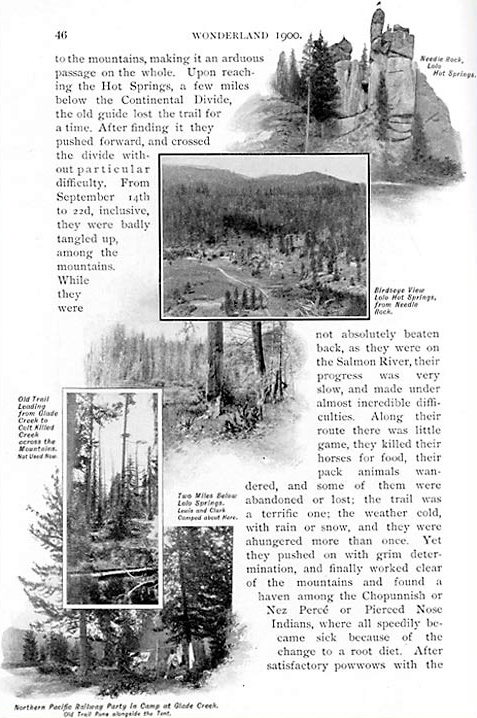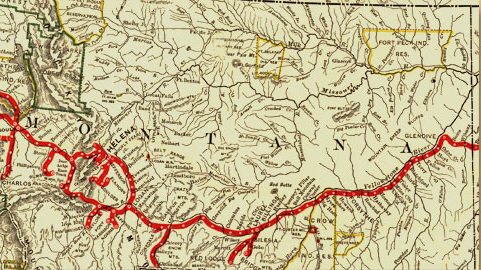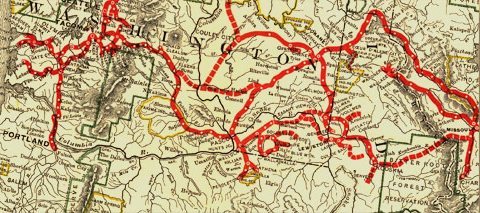One of Wheeler’s Railroad Promotions
Wonderland, 1900 (excerpt)
© 1900 Northern Pacific Railway.
This typical page from the lead article in Wonderland 1900 featured five photographs, taken in 1899, of scenes in the vicinity of Lolo Hot Springs, near the east end of the Northern Nez Perce Trail—K’useyneiskit, The Road to the Buffalo—which the Corps of Discovery followed across the Bitterroot Mountains in 1805 and 1806. The entire 71-page article contained 69 black-and-white photographs, more than half of which emphasized the finest achievements of 19th-century technology, showing NP locomotives, rolling stock, bridges, and trestles.
In 1884 the Northern Pacific Railway initiated an annual publication to meet the competition from other railroads in the area of information and promotion.[1]The Southern Pacific Railroad followed the Northern Pacific’s lead in 1898, creating its own promotional magazine, Sunset. Named after its famous mainline “Sunset Limited,” its … Continue reading The first few issues were actually brochures consisting of a single sheet folded so as to present 15 pages of text and illustrations, opening out to show a map on the opposite side, the whole “descriptive of the region tributary to the Northern Pacific Railway,” spotlighting one or more attractive tourist destinations that the writer himself had visited. It was soft-sell advertising of the type Charles Willson Peale had developed at the turn of the 19th century for his natural history museum. It appealed to natural curiosity, teased into action by lively reporting and graced with attractive see-it-to-believe-it illustrations. It was the beginning of a new industry that well before the next century was over would be known as cultural tourism.
The first issue of the NP’s series was titled Alice’s Adventures in the New Wonderland, a bit of literary license implying a correspondence with the astonishing surreality of the realm explored in Lewis Carroll’s popular children’s book of 1865. The title of the next issue was the same, but its subtitle was more explicit. The “New Wonderland” was Yellowstone National Park, which had been established in 1872. The 1888 issue was John Hyde’s Wonderland, or, The Pacific Northwest and Alaska. The 1892 issue, written by Albert B. Guptil, was titled A Ramble in Wonderland: Being a Description of the Marvelous Region Traversed by the Northern Pacific Railroad.
Olin Wheeler took over as writer and producer of the NP’s promotional journal in 1893, at once improving and expanding it. His first issue was a 100-page magazine featuring scenic engravings, duotones, and black-and-white photographs. Its title and scope reflected the energy of its author-traveler: 6,000 Miles Through Wonderland—referring not only to the NP Railway from Duluth to the Pacific, but also to the route of the company’s steamship line north to Ketchikan, Juneau, and Seward, Alaska. The following year it was called Indianland and Wonderland; 1895’s issue was Sketches of Wonderland. From then until 1906 its banner heading was simply Wonderland, followed by the year.
Northern Pacific Railroad, 1900
The Northern Pacific Railroad in 1900
Glendive to Missoula, Montana
To see labels, point to the map.
Library of Congress Geography and Map Division.
Dashed red lines identify proposed branches and connecting lines as of 1900, the year the map was published. Dotted green lines show the Lewis and Clark trail.
The Northern Pacific Railroad linked Duluth, Minnesota, at the westernmost point in the Great Lakes, with Portland, Oregon, at that time the seaport that was farthest up the Columbia River. Its main line ran almost due west from Duluth through Bismarck/Mandan, North Dakota, where it intersected with the Missouri River and the Lewis and Clark Trail, and continued straight west as far as Glendive, Montana. From Glendive it followed the Yellowstone River southwest to to Livingston, crossed the first range of the Rockies to Bozeman, and proceeded northwest to the Three Forks of the Missouri. There one branch led northward along the Missouri as far as Helena, the other west to Whitehall, thence south to Twin Bridges at the mouth of the Big Hole—Lewis and Clark’s “Wisdom”—River.
Meanwhile, competition for western routes and markets in a region that seemed to offer unlimited opportunity, stimulated other railroad companies into action, initially following water-level rights-of-way along all the major rivers, including the Missouri. Numerous spurs and branch lines sprang up to serve mineral and timber concerns, as well as farms and ranches.
Henry Villard, the financier who completed the Northern Pacific in 1883, also owned the Oregon Railroad and Navigation Company, which had already laid track along the lower Columbia River and was also operating steamboats as far inland as The Dalles. Wheeler himself knew what additional developments were being planned, such as the Camas Prairie Railroad, begun in 1909, that followed the North Bank of the Snake River between the Columbia and Lewiston, Idaho.
Wheeler’s Expedition Summaries
Wonderland 1900 opened with Wheeler’s 71-page summary of the Lewis and Clark expedition. Wonderland 1901 included an article by Wheeler on “One of Lewis and Clark’s Men,” William Bratton, inspired by a letter he received from one of Private Bratton’s descendants after the previous year’s issue appeared. Wonderland 1903 contained Wheeler’s expanded account of his 1902 excursion across the Lolo Trail, “One Hundred and Fifty Miles with a Pack Train.” In Wonderland 1904, “The Lewis and Clark Renaissance” was a brief account of the Lewis and Clark fair in Portland—a prime destination for west-bound tourists—and the following year’s issue included a review of the same “Lewis and Clark Exposition.”
The Northern Pacific Railway had identified two new attractions within its Wonderland—a centennial commemoration of the historic Lewis and Clark expedition, plus extensive segments of the original trail within sight of its rails. Olin Wheeler was inspired by the breadth and depth of the expedition’s history, which he had studied thoroughly and first-hand; he possessed the resources and the experience to create a new interpretation of it; and he had the opportunity provided by his employer’s support and encouragement. He called it simply The Trail of Lewis and Clark, 1804-1904.
Portland’s Lewis and Clark Centennial
Verses on the Prospect of Planting Arts
and Learning in America
By George Berkeley (1685-1753)[2]Alexander Campbell Fraser, ed., The Works of George Berkeley, 4 vols. (Oxford: Clarendon Press, 1901), 4:365-370.
The Muse, disgusted at an age and clime
Barren of every glorious theme,
In distant lands now waits a better time,
Producing subjects worthy fame.
In happy climes, where from the genial sun
And virgin earth such scenes ensue,
The force of art by nature seems outdone,
And fancied beauties by the true:
In happy climes, the seat of innocence,
Where nature guides and virtue rules,
Where men shall not impose for truth and sense
The pedantry of courts and schools:
There shall be sung another golden age,
The rise of empire and of arts,
The good and great inspiring epic rage,
The wisest heads and noblest hearts.
Not such as Europe breeds in her decay;
Such as she bred when fresh and young,
When heavenly flame did animate her clay,
By future poets shall be sung.
Westward the course of empire takes its way;
The four first Acts already past,
A fifth shall close the Drama with the day;
Time’s noblest offspring is the last.
In 1899, on the eve of what publisher Henry Luce would label, forty-two years later, “the American century,” Olin D. Wheeler was working for the Northern Pacific Railway, headquartered in St. Paul, Minnesota, preparing promotional publications to draw attention to the northern transcontinental railroad line, and to the region it served. That April saw the signing of the Spanish-American War peace treaty, and the United States’ acquisition of the Philippines, Guam, and Puerto Rico. The national economic crisis of 1893 was history, and—even while debate raged about what the United States should do with the new “territories” acquired from Spain (“colonies” being an unacceptable term to Wheeler). The national mood was optimistic and expansive. Only three states remained to be admitted to the contiguous continental United States: Arizona, New Mexico, and Oklahoma (until 1907 officially designated Indian Territory). It seemed obvious that America’s manifest destiny was on the brink of fulfillment.
Indeed, the United States would soon hold up its history and achievements for the whole world to admire—again.[3]The first world’s fair was held in London in 1851, the second in New York (1853). Philadelphia presented the ninth one (1871); New Orleans the eleventh (1884). Number seventeen was … Continue reading Two international expositions, one near the nation’s heart, the other near its westernmost extent, would be emphasizing its self-confident, energetic westward expansion, which would aptly symbolized by the Lewis and Clark Expedition. One was a world’s fair scheduled for St. Louis in 1904 (the Louisiana Purchase Exposition, which included the summer Olympic games). The other, in Portland, Oregon, in 1904-05, was grandly named The Lewis and Clark Centennial and American Pacific Exposition and Oriental Fair, but most people called it simply the Lewis and Clark Exposition. In what had already become the usual world’s fair format, exhibits would range from technological innovations to national history, regional agricultural development, and glimpses into the cultures of indigenous peoples.[4]Robert Rydell, “Visions of Empire: International Expositions in Portland and Seattle, 1905-1909,” Pacific Historical Review, 52 (February 1983): 37-42.
The triumphant motto of the Portland celebration was “Westward the Course of Empire Takes Its Way.” The expression came from a poem by George Berkeley (1685-1753), an Irish bishop, philosopher, and mathematician who briefly lived in America during the early 1730s. The symbolic West of Berkeley’s poem was the idealized North American continent that lay beyond the Atlantic Ocean. The simple aphorism with which the last stanza began was revived in the late 19th century as a theme and banner for American national ambition and action. Its sentiment was vividly expressed in the context of the bright, promising American West, in a famous painting (c. 1862) by Emanuel Leutze for the U.S. House of Representatives, where it still hangs.
Clearly, it was time to take a new look at the story of the Lewis and Clark expedition—the story Elliott Coues described as “our national epic of exploration, conceived by Thomas Jefferson, wrought out by Lewis and Clark, and given to the world by Nicholas Biddle.”[5]Elliott Coues, ed., The History of the Expedition Under the Command of Lewis and Clark, 3 vols. (1893; repr., New York: Dover, 1965), 1:vi. It was doubtful, Wheeler was soon to observe, “whether, a century ago, except to a very few far-sighted individuals, the real importance and value of that great exploration were even half apparent to the world. It has required a hundred years of progress and perspective to perceive what, coupled with the Louisiana Purchase and Gray’s discovery of the Columbia river, it really did mean.” Wheeler himself was in unique a position to organize, implement, and articulate that new view.
Born in Ohio in 1852, Wheeler had worked as a topographer for John Wesley Powell’s Colorado Plateau survey from 1874 through 1879. In 1882, Wheeler’s career shifted and he began ten years’ work as a freelance adman in St. Paul, Minnesota, which led to his being hired by the Northern Pacific Railway. He continued with the Northern Pacific, eventually as chief passenger agent, until retiring in 1909, sixteen years before his death.
Notes
| ↑1 | The Southern Pacific Railroad followed the Northern Pacific’s lead in 1898, creating its own promotional magazine, Sunset. Named after its famous mainline “Sunset Limited,” its purpose was to “chronicle the world of the West over which the dawn of future commercial and industrial importance is just beginning.” The SP’s counterpart to Yellowstone was Yosemite National Park. In 1914 the railroad sold the magazine to a group of its own employees. They expanded it to twelve issues per year and raised its level of appeal with fiction by Mark Twain, Jack London, Zane Gray, Dashiell Hammett, Sinclair Lewis, and Bret Harte. The NP’s Wonderland series ceased publication with the 1906 issue. |
|---|---|
| ↑2 | Alexander Campbell Fraser, ed., The Works of George Berkeley, 4 vols. (Oxford: Clarendon Press, 1901), 4:365-370. |
| ↑3 | The first world’s fair was held in London in 1851, the second in New York (1853). Philadelphia presented the ninth one (1871); New Orleans the eleventh (1884). Number seventeen was Chicago’s (1893), followed by San Francisco (1894), Atlanta (1895), and Buffalo, New York (1901). The 1904 fair in St. Louis was the twenty-third. The Portland, Oregon, celebration didn’t make the official list. |
| ↑4 | Robert Rydell, “Visions of Empire: International Expositions in Portland and Seattle, 1905-1909,” Pacific Historical Review, 52 (February 1983): 37-42. |
| ↑5 | Elliott Coues, ed., The History of the Expedition Under the Command of Lewis and Clark, 3 vols. (1893; repr., New York: Dover, 1965), 1:vi. |
Experience the Lewis and Clark Trail
The Lewis and Clark Trail Experience—our sister site at lewisandclark.travel—connects the world to people and places on the Lewis and Clark Trail.
Discover More
- The Lewis and Clark Expedition: Day by Day by Gary E. Moulton (University of Nebraska Press, 2018). The story in prose, 14 May 1804–23 September 1806.
- The Lewis and Clark Journals: An American Epic of Discovery (abridged) by Gary E. Moulton (University of Nebraska Press, 2003). Selected journal excerpts, 14 May 1804–23 September 1806.
- The Lewis and Clark Journals. by Gary E. Moulton (University of Nebraska Press, 1983–2001). The complete story in 13 volumes.




